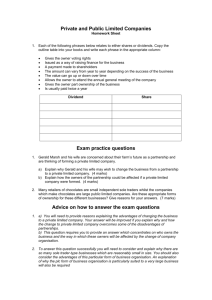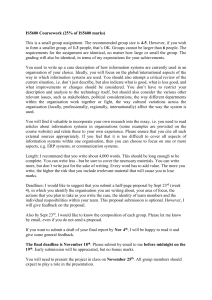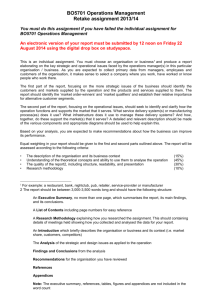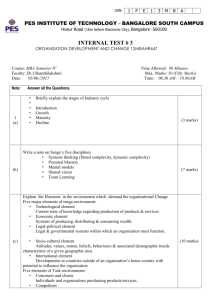Assignment Guidelines Management of Financial Resources and
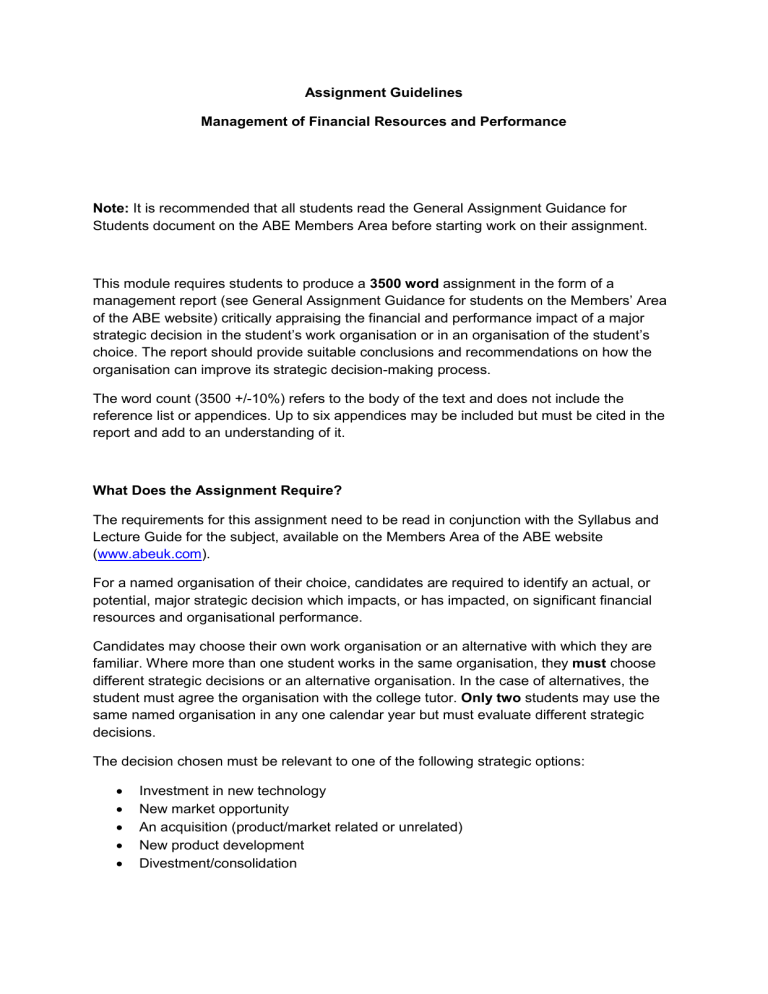
Assignment Guidelines
Management of Financial Resources and Performance
Note:
It is recommended that all students read the General Assignment Guidance for
Students document on the ABE Members Area before starting work on their assignment.
This module requires students to produce a
3500 word
assignment in the form of a management report (see General Assignment Guidance for students on the Members’ Area of the ABE website) critically appraising the financial and performance impact of a major strategic decision in the student’s work organisation or in an organisation of the student’s choice. The report should provide suitable conclusions and recommendations on how the organisation can improve its strategic decision-making process.
The word count (3500 +/-10%) refers to the body of the text and does not include the reference list or appendices. Up to six appendices may be included but must be cited in the report and add to an understanding of it.
What Does the Assignment Require?
The requirements for this assignment need to be read in conjunction with the Syllabus and
Lecture Guide for the subject, available on the Members Area of the ABE website
( www.abeuk.com
).
For a named organisation of their choice, candidates are required to identify an actual, or potential, major strategic decision which impacts, or has impacted, on significant financial resources and organisational performance.
Candidates may choose their own work organisation or an alternative with which they are familiar. Where more than one student works in the same organisation, they must choose different strategic decisions or an alternative organisation. In the case of alternatives, the student must agree the organisation with the college tutor.
Only two
students may use the same named organisation in any one calendar year but must evaluate different strategic decisions.
The decision chosen must be relevant to one of the following strategic options:
Investment in new technology
New market opportunity
An acquisition (product/market related or unrelated)
New product development
Divestment/consolidation
Candidates are required to appraise and use financial data and appropriate financial techniques and tools including investment evaluation
(as set out in Indicative Content 6.3) to evaluate the decision
(all Learning Outcomes, particularly LO6) and additionally apply
FIVE of the following financial resource or performance issues to the evaluation of the decision:
Either:
Evaluate the impact of the decision on the organisation’s financial statements and the relevance of this impact on the decision
(1.1)
.
Or:
Consider the limitations of the impact on the financial statements and the potential for manipulation in order to achieve a desired outcome
(1.2)
.
Either:
Evaluate the different methodologies and approaches to identifying appropriate cost information to support the decision and control expenditure
(2.1,
2.2)
.
Or:
Critically analyse the role and limitations of budgets in managing and controlling expenditure. Approaches to driving value through better budgeting
(2.3)
.
Appraise the role of activity based approaches and strategic management accounting in analysing the decision
(3.1, 3.2, 3.3)
.
Either
Critically assess the management and allocation of resources and gaps between needs and availability resulting from the decision
(4.1; 4.2)
.
Or:
Assess the potential for and use of best-in-class benchmarking to support the decision process
(4.3)
.
Either:
Consider the tensions between financial objectives, stakeholder expectations and agency issues
(5.1)
.
Or:
Appraise the role of treasury management in supporting the decision
(5.3)
.
Or:
Identify and evaluate the impact of alternative financing available and appropriate to the decision
(5.2)
.
Identify and evaluate international aspects of the decision including risk, additional complexities and financing
(7.1, 7.2, 7.3)
.
Evaluate the sources and consequences of risk associated with the decision and how these risks may be managed
(8.1, 8.2, 8.3)
.
Each issue above refers to the Indicative Content in the Lecture Guide for the unit (available on the Members’ Area of the ABE website) . Candidates should refer to the Lecture Guide for content and areas to cover in considering each financial resource or performance issue.
Note: You must ensure that each issue chosen is from a different unit Learning
Outcome.
Marking scheme
The assignment will require students to undertake the tasks and structure the assignment report to meet the marking scheme. Knowledge of relevant theories/literature and evidence of research must be included in each task.
Identification of the strategic decision and its strategic significance
10% of the marks are allocated for:
Identification of an appropriate strategic decision.
Valid and substantiated reasons for the choice.
Evaluate the strategic decision using strategic investment and financial appraisal
20% of the marks are allocated for:
Evaluating the suitability, acceptability and feasibility of the decision.
Critical evaluation of the validity and reliability of alternative techniques that could be used to appraise the decision.
A quantitative appraisal of the decision.
Incorporation of non-quantifiable issues including political and organisational.
Note:
See topics to cover under indicative content for 6.1, 6.2, and 6.3 in the Lecture Guide, including the examiner’s tips.
Critical evaluation and application of the additional five chosen learning outcomes
50% (up to 12% for each LO within the 50%) of the marks are allocated for a theoretical and research based evaluation of the financial resource or performance issue in the context of the strategic decision being considered in the assignment.
In all cases the application of the issue to the decision needs to be included.
Follow the content of the Lecture Guide and examiner’s tips. The marks will be allocated approximately equally as follows:
Relevant theory.
Research based evaluation of data.
Application to the decision.
Conclusions.
Conclusions and recommendations from the study
20% of the marks are allocated for:
Integration of the research covered in the study.
Strengths and weaknesses in the organisation’s strategic decision-making process.
Conclusions and final evaluation of the success or failure of the process.
Recommendations on how the organisation can improve its strategic decisionmaking process.
Word Count
The word count for this assignment is 3,500 words. A tolerance of +/- 10% is allowed where no penalty is incurred.
Where an assignment falls outside this tolerance the total mark awarded will be reduced.
Assignments which are up to 10% under or above the word count tolerance will be subject to a deduction of 5 marks, with subsequent penalties of an extra 5 marks deducted for every further 10% as shown below:
Percentage over or under the tolerance Marks deducted
Up to 10%
Every further 10%
5 marks
A further 5 marks
For clarification the word count applies to the entire body of the text (i.e. including headings, citations, content of tables and diagrams) but does not
include the reference list or the appendices.
Materials included in appendices should add to the reader’s understanding of the assignment. All appendices must be cited within the body of the assignment and must be clearly numbered.
An accurate electronic word count must be noted on the front of all assignments. The penalty for not providing a word count, or for providing an inaccurate word count, will be a deduction of 3 marks.
Selection of companies
Students are not permitted to select a company from the Corporate Strategy, Governance and Ethics in the Global Environment list for their assignment in Management of Financial
Resources and Performance, unless the student works full time for one of the organisations in that list. When writing an MFRP assignment, students should use smaller, nationally-based, or local companies with which they are familiar and for which they can obtain relevant information.
